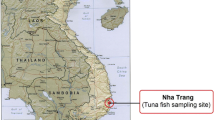Abstract
Neutron activation analysis was used to investigate and quantify the level of heavy metal uptake in the marine environment of Lake Austin in Austin, TX. Specifically, the samples studied were largemouth bass, or micropterus salmoides. The presence of heavy metals in the food chain presents multiple hazards, mostly as a food hazard for those species that ingest the fish, namely humans. To measure the concentrations of heavy metals in various fish samples, the nuclear analytical technique of neutron activation analysis (NAA) was used. Both epithermal and thermal irradiations were conducted for the NAA to look for short and long-lived radioisotopes, respectively. The samples themselves consisted of liver and tissue samples for each of the fish caught. Each sample was freeze-dried and homogenized before irradiation and spectrum acquisition. The results showed that all levels of heavy metals were not sufficient enough to make the fish unsafe for eating, with the highest levels being found for iron and zinc. Gold was found to be at much higher concentrations in the younger fish and virtually non-existent in the larger of the samples.
Similar content being viewed by others
Explore related subjects
Discover the latest articles, news and stories from top researchers in related subjects.Avoid common mistakes on your manuscript.
Introduction
The monitoring of heavy-metal concentrations in environmental settings is conducted frequently for many purposes, as heavy elements are relatively common in the environment. Anthropogenic sources of heavy metals are often introduced into ecosystems through various industrial pathways, such as mining wastes and improper manufacturing waste disposal [1]. Ingesting large amounts of heavy elements may cause acute or chronic heavy element toxicity. Acute heavy element toxicity can result in reduced mental and central nervous system function, lower energy levels, and damage to vital organs. Long-term heavy element toxicity can result in more severe physical, muscular, and neurological degenerative processes which mimic Alzheimer’s disease, Parkinson’s disease, muscular dystrophy, and multiple sclerosis [2].
The focus of this study is to determine the concentration levels of certain heavy metals in marine life of Lake Austin in the Austin, TX. In finding these concentrations, we can verify the varying levels due to the age of the fish. Fish may absorb heavy elements through three biological pathways. These pathways are the skin, the gills, and the alimentary tract. Relatively little is known about the mechanisms by which fish absorb heavy elements through the skin. That said, it is safe to assume that heavy metals are not absorbed through the skin to an appreciable degree. There is some evidence to suggest that a thin layer of mucus is responsible for preventing heavy elements from entering the bodies of fish through the skin [3].
As the main gas exchange organ, the gills represent a very important heavy element absorption point. There is experimental evidence to suggest that the gills of fish absorb substantial amounts of soluble heavy elements immediately after exposure. These heavy elements are then distributed throughout the body and accumulated in specific organs. However, fish absorbing heavy elements through the gills tend to retain the majority of the absorbed heavy elements in the gills themselves [3].
Heavy element particulates may enter the bodies of fish in the form of suspended particles, sediments, and food via the alimentary tract. Because the aquatic environments inhabited by fish are often polluted to at least a small degree, food represents a particularly important medium through which heavy elements may be absorbed through the alimentary tract. Furthermore, foods containing heavy metals generally contain relatively high concentrations of heavy metals. Fish absorbing heavy elements through the alimentary tract tend to retain the majority of the absorbed heavy elements in the liver and kidney [3]. At this point, it should be noted that if heavy elements are absorbed through both the gills and the alimentary tract, absorption through the alimentary tract generally dominates [3].
Studies have also been conducted to measure the level of these elements in the water and sediment of the lakes in which the fish reside. The level of heavy metals within the sediment is generally orders of magnitude greater than that of the aqueous concentrations. Some studies are also proposing various chemical extraction techniques to estimate the correlation between sediment levels and those found in marine life [4, 5].
This study will use instrumental neutron activation analysis (NAA) to determine the trace elements within the fish samples. NAA provides a non-destructive method for measuring elemental make-up of a sample for a large number of elements. The tests allow for multiple irradiations given the proper decay time is allowed between exposures to a neutron flux. Depending on the elements of interest, there exist a set that produce short-lived excited states that are ideally tested for first. Once these decay away, a longer irradiation can be conducted and then an appropriate decay time will be given for the shorter-lived isotopes to decay away. NAA also provides suitable detection limits as well as low uncertainties given the sample is of adequate size, appropriate sample activity post irradiation, and the testing standards have substantial amounts of the elements of interest.
Experimental
To quantify the levels of heavy metals in the fish, two samples were taken from each fish: a tissue sample and a liver sample. The reason for this choice was for the role in the food chain that these fish represent, the human food chain, this species is commonly caught for sport as well as food. The tissue samples are most likely those to be ingested. There are a total of 16 samples, two samples from a total of eight fish. Although the age and size of the fish are related, the age of the fish was not determined as there are only limits placed on the actual size of the fish. The sizes for the eight samples ranged from 8.2 cm at 3.8 ounces to 34.9 cm at 61.2 ounces. The samples numbers used in Figs. 1, 2, 3, 4, 5 are arranged in decreasing age/size, i.e. Sample 1 is the largest and Sample 8 is the smallest.
To prepare the samples, both the tissue and liver samples were first freeze-dried 48 h at a pressure of approximately 66.7 Pa and a temperature of approximately −25 °C. The samples were then ground into a fine powder so as to homogenize the sample for uniform irradiation. The samples were irradiated using the MARK II TRIGA reactor at the Nuclear Engineering Teaching Laboratory in Austin, TX.
For the short-lived isotopes (molybdenum, arsenic, cadmium, and gold), the samples were irradiated at 500 kW for 2 h. The samples were counted fairly soon after irradiation using high-purity germanium gamma detectors. For the long-lived isotopes (cesium, cobalt, chromium, iron, nickel, selenium, and zinc), the same were irradiated for 6 h using the TRIGA rotary specimen rack (RSR) to attain a more uniform and homogeneous flux exposure. The samples from this irradiation were also counted using the germanium gamma detector system. Proper background and decay time corrections were made for the resulting spectra and the samples were analyzed using the comparator method. For this method, liquid standards for each of the elements were prepared and irradiated along with the samples. With the comparator method, the flux does not need to be known, as it would be the same for the irradiation of the samples and standards. Using the counts obtained from the standard, a ratio can be constructed to solve for the amount of a particular element in comparison to the amount known to be in the verified standard. Using this method, the ratio factor that calculates the amount is now independent of the flux for the most part. One aspect that also has to be taken into account is differences in the axial distribution of the flux. Using cobalt wire flux monitors, factors can be found to compensate for the differences in the flux along the length of the test space. Standard error propagation was performed based on the uncertainties found in the standards.
Results and conclusions
For all of the following results, the concentrations are given in terms of parts per million with regard to the dry weight of the tested sample. As mentioned before, the dry weight was a result of the desiccation process, which was necessary for the proper irradiation and gamma ray spectra acquisition. The concentration levels of the short irradiations are shown in Figs. 1 and 2. In these figures, it can be seen that while molybdenum and arsenic had levels present in most of the fish, the cadmium levels were almost three times as large for the liver sample of one particular fish. With arsenic, the level of was roughly three times larger for a particular fish when looking in the liver versus the tissue. The values obtained for the long-lived isotopes are presented in Figs. 3, 4, and 5. In these figures, the levels of iron and zinc are by far the largest in magnitude as expected. These elements are usually tolerated in higher levels, as they are generally found in the nutritional requirements of most animals.
Another trend seen was that the concentration of gold was essentially non-existent in most of the larger fish; however, for the samples of the fish that were smaller (i.e. younger), the gold concentrations were much larger and had a value of approximately 0.32 ppm for the tissue sample of the youngest specimen studied. Also, the concentrations were found to be greater in the tissue than in the liver in contrast to the other heavy metals studied. The gold findings were unexpected and, therefore, the behavior is not fully understood. Further tests could be conducted to examine the mechanisms for this bias in the younger fish.
Previous work done in characterizing heavy metals in fish allows some level of qualitative comparison; however, the studies presented the concentrations found for wet weight. Therefore, comparing the concentrations found in this study, which were for dry weights only, to those found in previous studies is not logical. Further studies should be conducted in other regions to allow for a comparison to this work. However, it was concluded that the fish are safe for consumption at the levels measured in this study.
References
Lee YH, Stuebing RB (1990) Bull Environ Contam Toxicol 45:272–279
Life Extension Report. Heavy metal toxicity (2003) http://www.lef.org
Dallinger RF, Prosi F, Segner H, Back H (1987) Oecologia 73:91–98
Conder JM, Lanno RP (2001) J Environ Qual 30:1231–1237
Öztürk M, Özözen G, Minareci O, Minareci E (2008) J Appl Biol Sci 2(3):99–104
Author information
Authors and Affiliations
Corresponding author
Rights and permissions
About this article
Cite this article
Weaver, J., Wilson, W.H., Biegalski, S.R.F. et al. Evaluation of heavy metal uptake in micropterus salmoides (Largemouth Bass) of Lake Austin, TX by neutron activation analysis. J Radioanal Nucl Chem 282, 443–447 (2009). https://doi.org/10.1007/s10967-009-0345-7
Received:
Accepted:
Published:
Issue Date:
DOI: https://doi.org/10.1007/s10967-009-0345-7









